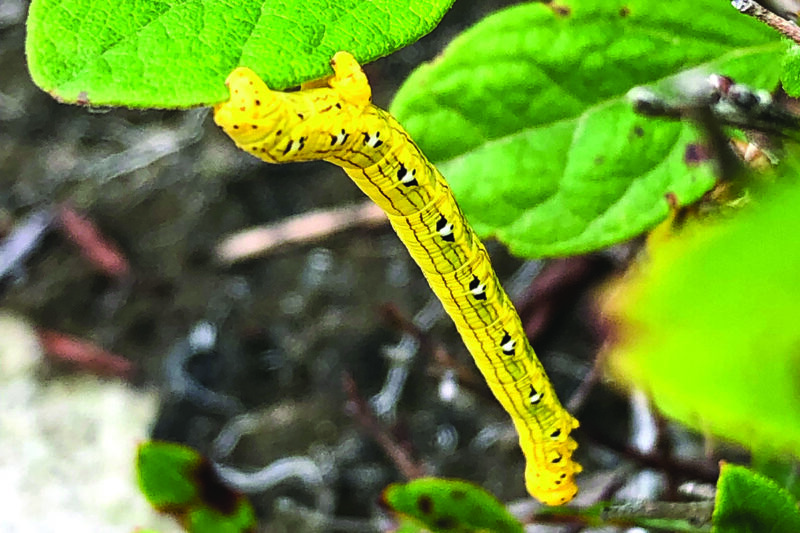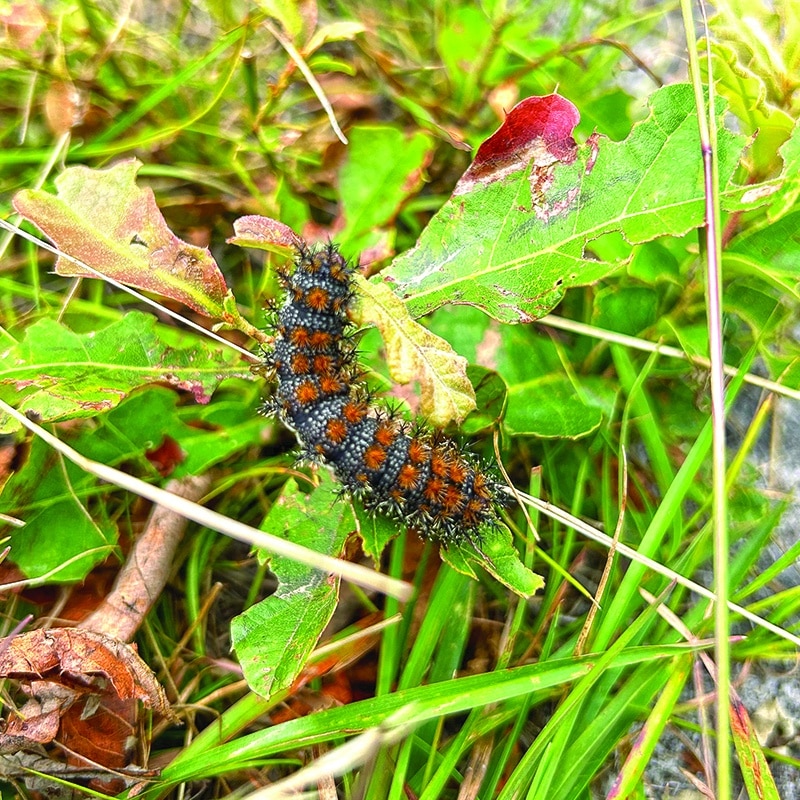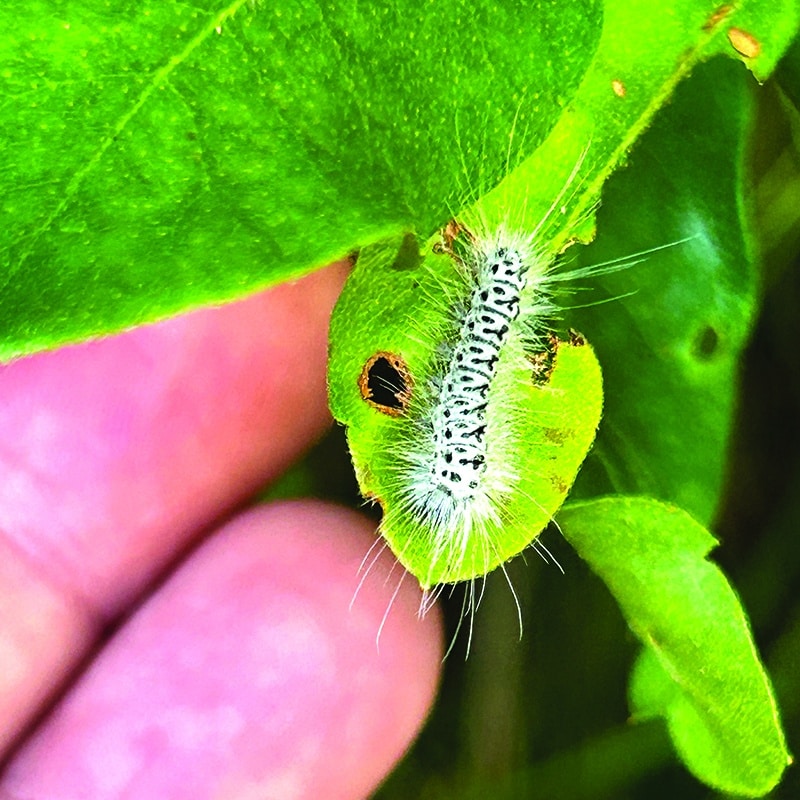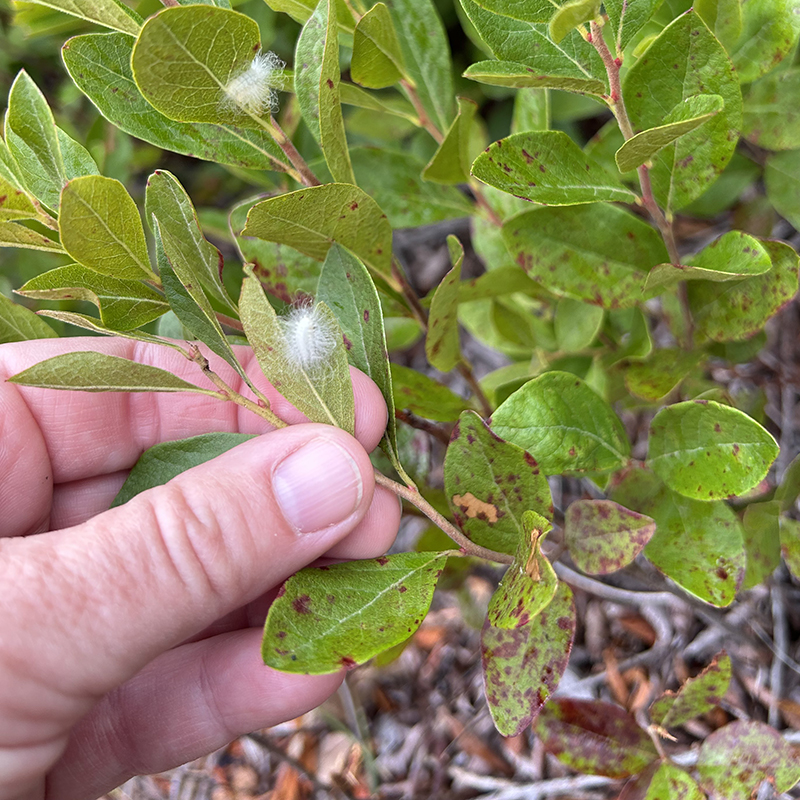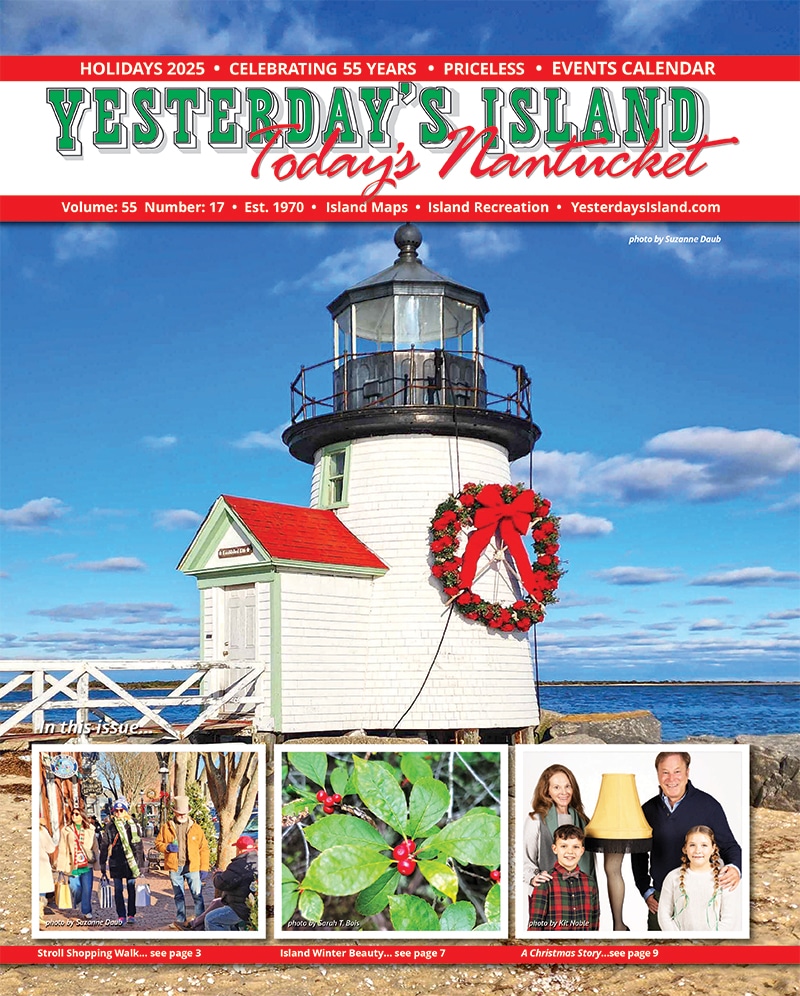by Dr. Sarah Treanor Bois, PhD
Director of Research & Education at the Linda Loring Nature Foundation
This past week we wrapped up the Nantucket BioBlitz. When we were out and about trying to catalog every living thing on the island mid-July, we came across a plethora of caterpillars. As a plant ecologist, I’m usually more attuned to the flora rather than the fauna. However, when you get up close and personal with a plant, you have a front row seat to the faunal associates living off of, in, and around the plant.
This year, it was the caterpillar diversity that really struck me. During the two weeks in July of the BioBlitz, we had 74 species of lepidoptera. Lepidoptera is the name for an order of winged insects that includes butterflies and moths. You can check out the full list of observations during the BioBlitz online.
There were, as expected, monarch butterflies, tiger moths (the adults of wooly bear caterpillars), and yellow swallowtails – the charismatic adults. The crescents were also popular at this time of year: Northern Crescent, Pearl Crescent, and the similarly colored Red Admirals, Painted Ladies, and American Coppers. All of these are various patterns of reddish orange, gray, and black on their wings.
And what’s so cool for Nantucket is that a lot of our Lepidoptera are protected within the state of Massachusetts. It’s our plant diversity and abundance of certain food and host plants that make us a hot spot for lepidoptera diversity. It’s the low growing shrubs of the heathlands and scrub oak barrens that are true hotspots of moth and butterfly diversity.
Research from the early 2000s by lepidopterists Mark Mellow and (independently) Dave Wagner found that 56 species of conservation concern representing 11 families of Lepidoptera are recognized as dependent on shrubland habitats in the New England region, including 41% of state-listed moths and butterflies in Massachusetts. Twenty-nine percent of these species utilize scrub oak (Quercus ilicifolia) as a larval host and 14% use lowbush blueberries (Vaccinium angustifolium and V. pallidum), both common on Nantucket. In addition to Lepidoptera, a wide diversity of other invertebrates is dependent on pine barrens and other shrublands. The importance of these habitats results from unique soil conditions and temperature regimes, as well as the structure, species composition, and phenology of the plant community.
According to the Massachusetts Natural Heritage and Endangered Species Program, Sandplain Heathlands are habitat for “multiple uncommon plants in Massachusetts, including sandplain flax, sandplain blue-eyed grass, eastern silvery aster, purple cudweed, butterfly weed, and broom crowberry. They are part of a structural and successional continuum with other coastal communities.” They are disturbance-dependent communities occurring on sandy and gravelly outwash plain and moraines near the coast.
The pitch-pine scrub oak barrens are an open shrubland plant community that occurs on outwash sandplains. These communities are not floristically very diverse. However, pitch pine/scrub oak barrens have a rich, specialized lepidopteran fauna. A large number of rare species of moths, particularly pitch pine and scrub oak feeders, have a strong affinity for the community type.
More than 60% of the rare moth fauna listed in the Massachusetts Endangered Species Protection Act are found primarily in scrub oak barrens, coastal heathlands, or sandplain grassland, all early successional habitats found on Nantucket. And 44% are restricted to native heathland or shrubland (including scrub oak barrens) habitat as described by Wagner et al (2003)— this number represents only a fraction of the 56 species of “Conservation Concern” they list as uncommon shrubland/heathland specialists.
I took a walk the other day to the Sesachacha Heathland property owned by the Massachusetts Audubon Society. The low growing heathland and scrub-shrub plant community had been historically maintained via prescribed fire and mowing, but not in recent years. And while adult butterflies and moths are cool, I really love the quirky shapes, sizes, textures, and colors of our caterpillars. Even in the short period of time of my walk, I found close to a hundred chain-dot geometers and five separate buck moth caterpillars cruising along the sandy trails.
Barren’s Buck Moth (Hemileuca maia) is a scrub-oak loving species and is a state-listed species of special concern. The small, black spikey caterpillars then become mottled black and white caterpillars with yellowish spikes and red heads. In either form, their spines pack a venomous punch, so refrain from touching them. In late September/October, the adult moths emerge with gorgeous black and white wings and colorful, fuzzy blackand- white-striped bodies with orange accents—perfect for Halloween time!
The yellow inchworm of the Chain Dot Geometer (Cingilia catenaria) is also a species of special concern in Massachusetts, primarily due to habitat loss and fire suppression. As an adult they have white wings with “chains” (lines) of black dots, hence the name. This time of year, though, they are the small yellow inchworm-like creatures with black stripes frequenting the heathland plant communities. We found many hundreds hanging around (literally) in the middle moors in a mowed scrub oak barren readying to cocoon.
The caterpillar of the Hickory Tussock moth (Lophocampa caryae) is completely covered in long, white, hairlike setae arranged in spreading tufts. Additional tufts of black with some longer hair clusters give this caterpillar a rock star appearance. These hairs cause itchy rashes in many people, particularly those prone to allergies, and may resemble exposure to urushiol, the chemical cause of poison ivy rash. While Hickory Tussock moths feed on nut trees, despite the name, they aren’t too picky. They are visible now on Nantucket, but will soon be tucked away in webs to pupate on their way to emerging as moths next spring. We found many of varying sizes in late July in the wooded areas of the Middle Moors and along the south coast at Smooth Hummocks.
This next caterpillar can be seen right now in its first instar stage. The puss or flannel moth, (Megalopyge crispata) looks cute and fuzzy, but DO NOT TOUCH! This little one has the distinction of being one of the most toxic caterpillars in North America. Closely resembling the cute backside of a rabbit, under the soft, white fuzz, this deadly creature has hollow poison-filled stinging spines that can act like tiny poison darts. While they won’t kill you, they pack a punch. I had to go to the emergency room when I accidentally squashed one into the palm of my hand. The swelling moving up my arm was concerning, but nothing that a few Benadryl couldn’t handle. So, look, but don’t touch this dangerous beauty.
Many of the species of interest that we’ve been finding are found in our heathland and scrub oak barren communities. Yet one more reason (besides all the amazing plants) to protect and manage these habitats. Keep that in mind next time you frequent one of the many conservation trails on-island.
If you’d like to know more about the caterpillars, their favorite host plants, and what time of year to expect them, check out Caterpillars of Eastern North America: A Guide to Identification and Natural History by David Wagner. This field guide with beautiful photographs categorizes around 700 species. My favorite part is that you can also look caterpillars up by host plant, narrowing the search.

